Originally published on SoundStage! Xperience
“Schiit happens.” It’s not the sort of language usually found in an owner’s manual for a headphone amplifier like Schiit Audio’s Jotunheim ($399 USD). No, an owner’s manual is usually full of bland marketing copy, loosened rules of grammar, regulatory warnings, and stultifying technical detail. I almost never use them, and unless you’re a novice audiophile, neither should you. The folks at Schiit seem to agree. In the preface to their safety instructions, they state: “The following is required by the roughly 9,542 government agencies and regulations we have to comply with. If you have some common sense, they should seem pretty straightforward.” Who are these guys? I did some digging.
Straight Schiit
Schiit Audio was founded in 2010 by Jason Stoddard, formerly of Sumo, and Mike Moffat, previously with Theta Digital and California Audio Labs. In the midst of the Great Recession, they correctly spotted the headphone wave that was gathering strength, and founded Schiit with an investment of $10,000 of their own cash. Their business model was and continues to be refreshingly simple and honest. They use quality components, but decided to forgo normal hi-fi distribution chains. They saw no need for sales reps to pitch their product to dealers, and no need for dealers or distributors. This meant that retail prices could be chopped in half by selling online, direct to buyers, while keeping the company’s profit margins intact. Schiit is hardly the first hi-fi company to take this approach, but I’d venture to say they’re one of the first to make it work.
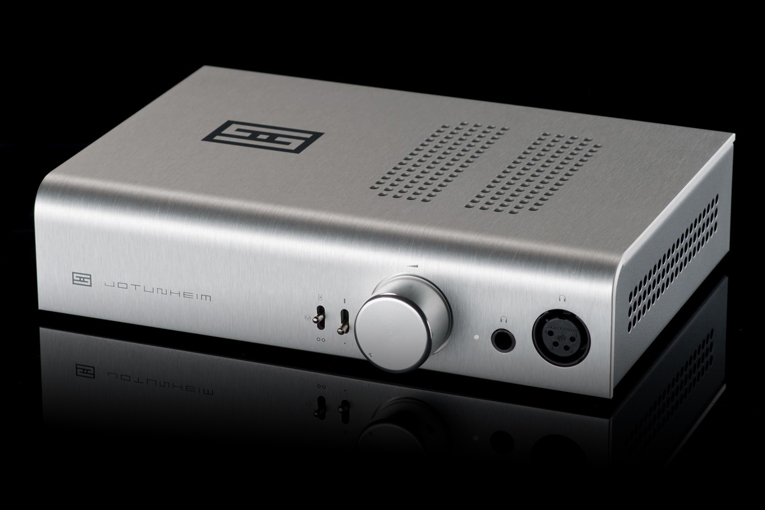
Schiit’s continuing story can be read in Schiit Happened: The Story of the World’s Most Improbable Start-Up, posted in serialized form at Head-Fi.org. It’s definitely worth reading -- a shockingly candid account of the trials and tribulations of a start-up company in this super-niche industry we all enjoy. If there has to be just one takeaway, it’s that Stoddard and Moffat chortle and roll their eyes at the audiophile establishment. They seem almost offended by companies that sell high-priced gear -- not by the prices themselves, but because they seem to have so little correlation with the costs of manufacturing and the final sound quality. I couldn’t agree more. There are a lot of good products out there, but the tweaky, elitist culture associated with the High End makes it fairly intimidating to a potential newbie; there are too many rules and expectations for what’s right and what’s not. Schiit couldn’t be bothered by such noise -- and it most definitely is noise. Schiit focuses on catering to their target buyers, over 60% of whom are under the age of 35, and maintaining their impressively rapid growth of 30-40% per year.
Schiit’s product line is as diverse as it is affordable. They make headphone amplifiers that retail from $99 for the Magni 2 to $1699 for the flagship Ragnarok, which is also a full-on power amplifier producing 60Wpc into 8 ohms. There are also preamps ranging from the $49 SYS to the $699 Freya, and digital-to-analog converters, from the $99 Modi 2 all the way up to Schiit’s most expensive offering, the $2299 Yggdrasil. As for design philosophies, Schiit is pretty catholic -- their amps and preamps can be had in class-A solid-state or tubed varieties, and some of their digital products can be optioned with delta-sigma or multi-bit DAC circuits. Rather than foist specific audio ideologies on their customers, Schiit prefers to make high-quality, affordable gear with a generous side order of irreverence.
The Jotunheim headphone amplifier is one of Schiit’s newest products, and judging by its specs alone, it’s a promising little device. The base price of $399 gets you single-ended (RCA) and balanced (XLR) inputs and outputs, and for another $100 you can add a balanced DAC with USB input or a passive moving-magnet phono stage. My review sample came with the DAC board.
My review sample came in a finish of flat black aluminum, with a volume knob of brushed silver, while a silver finish is also available. The case measures 9”W x 2”H x 6”D and weighs 6 pounds. At the right of the sloped front panel are a balanced, four-pin XLR headphone output and single-ended 1/4” headphone jack; to the left of these is the large volume knob, and to the left of that the Input and Gain switches. Gain can be toggled between 6dB and 14dB. On the rear panel is the master power switch, though Schiit says the Jotunheim can be left on full-time. The top panel has, on the left, a stenciled Schiit logo; on the right are dimpled vent holes through which two soft-orange LEDs can be seen, glowing like tubes; the side panels, too, are vented.
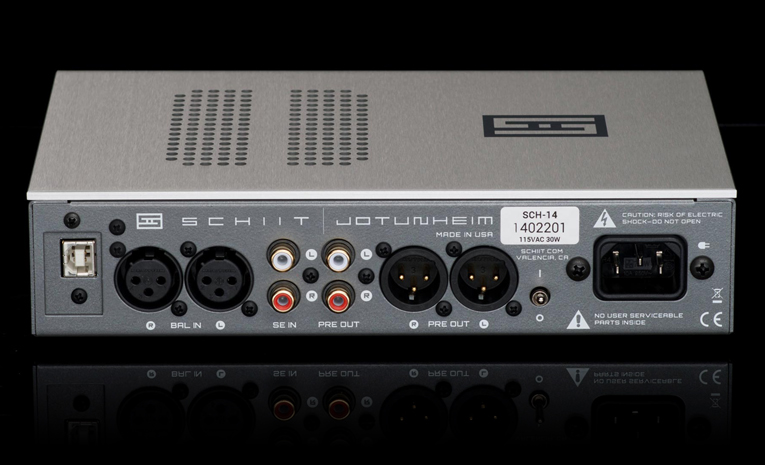
My review sample was accompanied by only a power cord and that brief owner’s manual. Interconnects, a 1/4” headphone adapter, and a remote control cost money and may not be useful to every buyer, so Schiit doesn’t provide them.
The Jotunheim feels solid and well built, and, like all Schiit products, is not only manufactured in southern California, but most of its parts, including its chassis and circuit boards, are also sourced from U.S. companies with domestic manufacturing. At a time when Chinese manufacturing has arguably far surpassed what’s commercially feasible in the States, it’s remarkable to see a company so invested in the slogan “Made in the U.S.A.” Schiit stands behind its products, offering a 15-day money-back guarantee (minus a 5% restocking fee) and a five-year limited warranty. Want to try before buying? Visit the company’s small showroom in Newhall, less than six miles from their factory in Valencia. It’s called the Schiitr. Seriously.
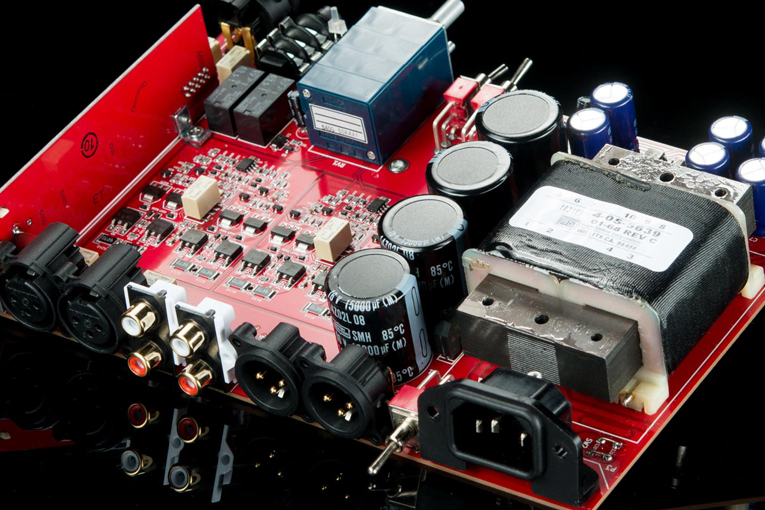
The guts of the Jotunheim are all discrete and specifically tailored to for this application -- there’s no amp on a chip, no reference DAC board. The inherently balanced class-AB circuit, designed in-house, can drive loads from 16 ohms all the way up to 600 ohms. With single-ended ’phones attached, the Jotunheim produces 175mWpc into 600 ohms, and 2.5Wpc into a 16-ohm load. In balanced operation, these power ratings increase, to 500mWpc and 7.5Wpc, respectively. The signal/noise ratio is greater than 109dB A-weighted, while the total harmonic distortion is specified as less than 0.001%, 20Hz-20kHz. The frequency response is 20Hz-20kHz, -0.1dB, with an output impedance of less than 0.1 ohm, regardless of gain setting or which headphone output is used. The gain stage uses Schiit’s discrete Pivot Point “differential current feedback topology.” Like every other Schiit product except the Fulla 2 DAC-headphone amp ($99), the Jotunheim has a linear power supply, as well as a 48VA transformer with six stages of regulation and over 70,000µF of filter capacitance.
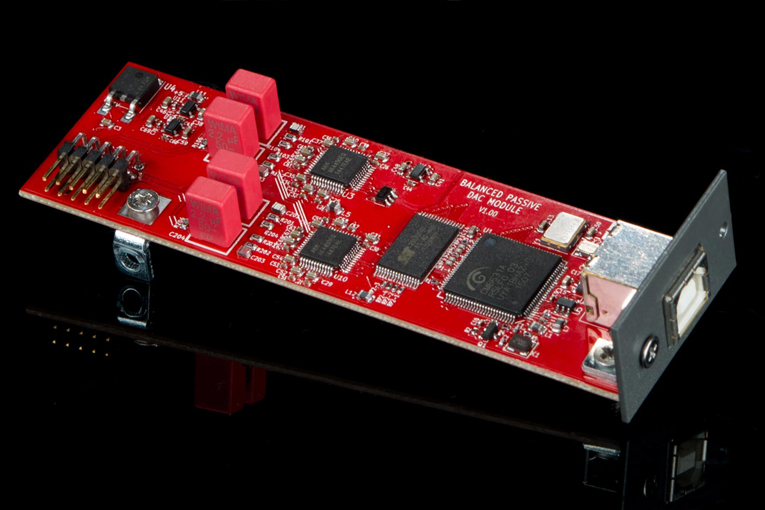
The optional DAC board is a custom, fully balanced design with one AKM AK4490 DAC chip per channel, and passive filtering. The board accepts PCM signals up to 24-bit/192kHz. (Schiit unapologetically ignores DSD and MQA.) The claimed THD is less than 0.0015%, 20Hz-20kHz, at rated power, while the signal/noise ratio exceeds 106dB, unweighted. The USB input receiver is a C-Media CM6631A. Of note is the presence, for a mere $100 extra, of a top-flight AKM DAC chipset in a dual-differential architecture -- the same arrangement used in Hegel Music Systems’ flagship digital product, the HD30 DAC ($4800). While an audio component’s sound quality is determined less by its parts list than by how those parts are implemented, Schiit’s use of such high-quality components is certainly promising.
Setup
My desktop system is pretty simple, with my workhorse MacBook Pro laptop serving as my digital source. I swapped out my reference Oppo Digital HA-2SE DAC-headphone amplifier and hooked up the Jotunheim via a generic USB cable, cued up Tidal and Roon, and was ready to stream PCM content to my small collection of headphones and earphones. These included my reference headphones, NAD’s Viso HP50s, as well as Pryma’s 01s, an ancient set of Grado SR125s, and my reference earphones, PSB’s M4U 4s. All are relatively easy to drive, so I unfortunately couldn’t challenge the Jotunheim with a brutal load, or ’phones superhungry for power. The gear on hand meant that I only ever used the Jotunheim’s unbalanced headphone jack, and did all of my listening with the lower gain setting of 6dB. I also briefly hooked up Oppo’s Sonica DAC to the Jotunheim’s balanced outputs via Nordost Blue Heaven LS XLR cables, to compare it with the Schiit’s optional DAC card.
I usually don’t give electronics much break-in time, but I received my review sample on a particularly bitter winter afternoon -- when I tried to dive right into listening, I found it pretty much unlistenable. The Jotunheim sounded thin in the treble, lifeless through the midrange, and totally gutless down low. I stopped listening, left the unit powered on (which Schiit recommends) for a day or two, listened again, and found the Jotunheim’s sound in much better shape.
Listening
The Schiit Audio Jotunheim is not a world-beating DAC-headphone amplifier -- I’ve heard more revealing one-box desktop models. But for $499 with optional built-in DAC, it’s a no-brainer recommendation for just about anyone. I’ve listened to this little guy for months and have yet to identify a sonic signature of any kind -- such has been the Jotunheim’s sterling neutrality. In fact, my extended listening highlighted a slight tonal coloration in my reference headphone amp, the Oppo HA-2SE, explained in more detail below. But as a jack-of-all-trades, do-it-all device, the little Schiit was nearly impossible to fault.
Consider the voice of actress Sarah Sutcliffe as she reads lines from Virginia Woolf’s novel Orlando, in “Memory Is the Seamstress,” from composer Max Richter’s Three Worlds: Music from Woolf Works (16-bit/44.1kHz FLAC, Deutsche Grammophon). The contours of Sutcliffe’s British accent were on full display in this lightly reverb’d track, as the Jotunheim laid out her well-articulated delivery in clear, orderly fashion. Listening through my NAD Viso HP50s, I was keenly impressed with the supple textures of her voice, easily discernible from the foreboding ether surrounding her. Enunciation was excellently reproduced, with sibilants presented smoothly and unfettered. Conspicuously absent was any digital hash or oversaturation of tonal color.
It was illuminating to compare Sutcliffe’s reading with that of Gillian Anderson, who, in the closing track of Richter’s experimental and mesmeric album, reads with a sense of eternal resignation Woolf’s suicide note to her husband. Sutcliffe’s voice is lighter and more delicate in its cadences; Anderson’s seems to emanate from deeper in the diaphragm, sounding more full and velvety. In Anderson’s utterly defeated-sounding reading of this monologue, the sounds of ocean waves seem to crash all around her, slightly obscuring her words. However, the Jotunheim was providing no upper-midrange emphasis that I could hear to make Anderson more intelligible. The Schiit was semper fidelis.
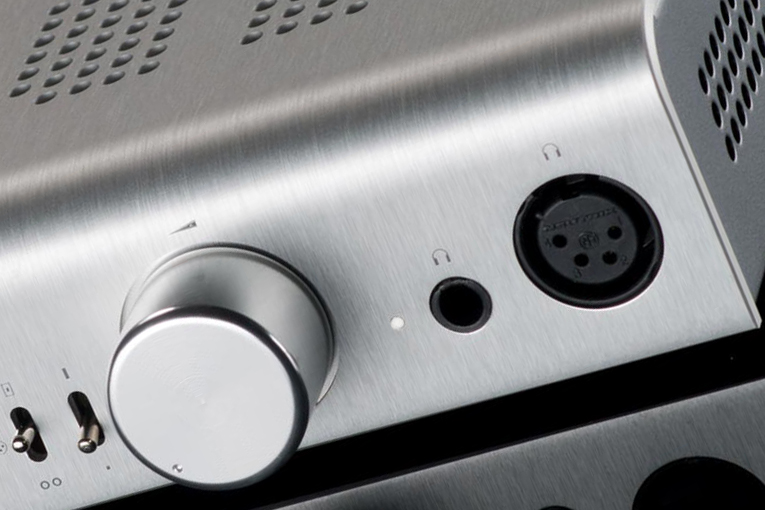
A little worried about a possible lack of treble extension, I traded my neutral-sounding NADs for my vintage pair of decidedly non-neutral Grado SR125s. I bought the Grados in 2000 or so, and while they were solid for the money back then, they haven’t aged particularly well. In fact, they sound, in a word, bright, to the point that extended listening to certain types of music isn’t really possible unless you’re something of a masochist. True to form, the SR125s were strident as could be when I cued up “Tamarack Pines,” from pianist George Winston’s solo album Forest (16/44.1 FLAC, Windham Hill). Winston’s right-hand explorations lend the cut a vibrant feel to begin with, but through the Grados, his aggressive upper-register notes bordered on the surgical. Yet while the Grados’ signature brightness was preserved, I still heard significant low-level detail, with a rapid attack and decay of each note and remarkably open, airy sound. Surely some of that spaciousness can be attributed to the Grados’ open-back design, but I was deeply impressed by how much of each model of headphones I heard through the Jotunheim, and how little of the amp itself.
With “We Will Rock You,” from Queen’s News of the World: Deluxe Remastered (16/44.1 FLAC, Island), I heard yet more of the Grados’ intrinsic character: a vibrant upper midrange that makes for a lively, exciting sound, but somewhat lightweight and lacking in conviction in the lower midrange. The famous opening lines illustrated this perfectly: the chorus’s clapped hands sounded a little sharper than they should, as did lead singer Freddie Mercury’s impassioned sibilants, while the foundation of the legend’s voice was somewhat recessed, putting greater emphasis on the track’s electric upper midrange and treble energy.
Wanting to test the Schiit’s dynamic capabilities, I cued up “No Time for Caution,” from Hans Zimmer’s delicious original soundtrack for Interstellar: Deluxe Version (24/44.1 FLAC, HDtracks), and donned my PSB M4U 4 in-ear monitors. This track propels at the listener a broad tapestry of sound with plenty of emotive strings, tinkling piano, and plenty of percussion, all coalescing in a powerful climax that ultimately gives way to a thundering organ passage. Through it all I was able to keep track of each section of the orchestra and a healthy number of individual instruments, while maintaining between my ears a coherent aural picture of the entire performance. Moreover, the organ was reproduced with comfortably controlled extension. The Jotunheim may not be the final word in outright transparency -- I would have preferred more individuation of and air around specific performers, and greater insight into the farthest reaches of the recording venue itself -- but I was a bit shocked to have heard as much as I did for $499. Whatever microscopic detail the Jotunheim missed, it more than made up for with its faithful re-creation of music’s flesh and bones -- and it doesn’t get much more complicated than one of Zimmer’s cinematic anthems.
Comparison
My reference headphone amp, Oppo’s portable HA-2SE ($299), isn’t a direct competitor for the more expensive Schiit Jotunheim. Most of that has to do with the fact that the Oppo is highly portable -- it’s about the size of an iPhone 5S -- and thus has nowhere near the power output of the Jotunheim, nor does it offer a balanced headphone output. In fact, it produces only about one-tenth the Schiit amp’s power. The HA-2SE does, however, have an ESS Technology ES9028-Q2M Sabre Reference DAC with USB input that can natively process DSD, and a high-quality, overachieving, class-AB amplifier circuit.
The Oppo and Schiit amps sounded remarkably similar to one another. Both had neutral, uncolored sound and big dynamics, and, for the money, were quite revealing of low-level detail. The HA-2SE’s sound diverged from the Jotunheim’s in two subtle ways, however. First, the Oppo has a liveliness through the midrange that contrasted with the Jotunheim’s smoother sound. In practical terms, this meant that the HA-2SE has more jump factor -- it’s a more exciting listen -- while the Jotunheim’s sound is a touch more dignified.

Second, the Oppo’s midrange seemed more prominent than the Schiit’s. With “We Will Rock You,” Mercury’s voice seemed pushed a bit farther forward through the HA-2SE compared to the Jotunheim -- the latter’s sound wasn’t flat, but perhaps a little veiled. But these differences were minute, and ultimately matters of preference. I didn’t hear any more or less of the music through the Oppo, just a slightly different take on it.
Because I suspect that most users will prefer to include the Jotunheim’s optional DAC card, I spent only a couple of hours trying to isolate its contributions to the overall sound. When I wired Oppo’s Sonica DAC ($699) to the Jotunheim’s balanced outputs -- not exactly a fair comparison, as Schiit’s DAC board costs only $100 -- I discovered that the characteristic smoothness I’d so far heard from the Jotunheim disappeared along with the subtle midrange veiling: I quickly felt that I could hear farther and deeper into each recording. This means that my only knock against the Jotunheim -- the slight one that it’s not the most revealing amp I’d ever heard -- can be laid at the feet of its absurdly affordable, dual-differential DAC board, and not the amplifier itself.
Conclusions
Schiit Audio’s Jotunheim is an excellent headphone amplifier that I’m confident just about anyone would like. Between its monster power output and its balanced and unbalanced inputs and outputs, it’s a veritable audio Swiss Army Knife that can play nicely with any set of headphones in any type of system. Having the option to order the Jotunheim with a moving-magnet phono board or a dual-differential DAC for a mere $100 makes the package even more appealing. Ultimately, though, it’s this little Schiit’s accomplished sound quality, highlighted by its sensational neutrality, that makes it so compelling. With the optional DAC in play, the Jotunheim is very good. But hook up a high-quality external DAC -- perhaps one of Schiit’s own -- and I suspect you’ll find that the sky’s the limit. Unless you’re keen to light some money on fire, begin your search for a top-flight headphone amp here.
. . . Hans Wetzel
Associated Equipment
- Earphones and headphones -- Grado SR125, NAD Viso HP50, Pryma 01, PSB M4U 4
- DAC-headphone amplifier -- Oppo Digital HA-2SE
- DAC -- Oppo Digital Sonica
- Source -- Apple MacBook Pro running Tidal and Roon
- Analog interconnect cables -- Nordost Blue Heaven LS XLR
Schiit Audio Jotunheim DAC-Headphone Amplifier
Price: $399 USD; balanced DAC board (as reviewed) or MM phono stage, add $100.
Warranty: Five years parts and labor.
Schiit Audio
24900 Anza Drive, Unit A
Valencia, CA 91355
E-mail:
Website: www.schiit.com







